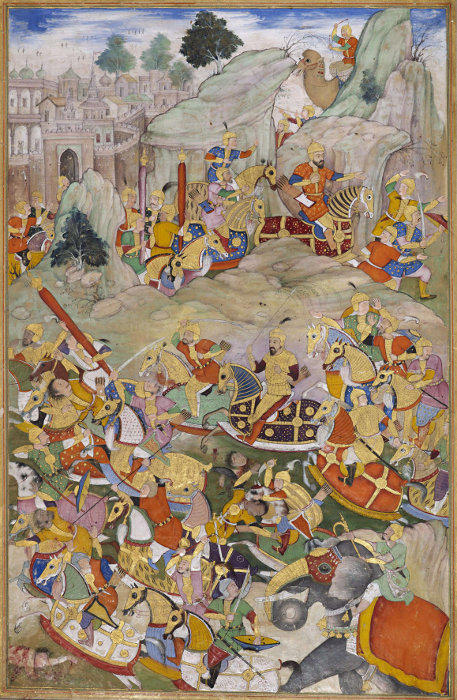
Create an Amazon Wedding Registry
Humayun Defeats His Rebellious Brother Kamran At Kabul, 1533
from the Akbarnama

A larger image of Humayun Defeats His Rebellious Brother Kamran At Kabul, 1533, from the Akbarnama


This painting illustrates a scene from the reign of Humayun, who encountered much resistance from his rival brothers, especially Kamran, the governor of Kabul and Qandahar in modern Afghanistan. Although Humayun had distributed the various provinces of the empire he had inherited to each of his four brothers, soon Kamran had banded together with another brother, Askari, and seized control of the Punjab from Humayun. Humayun was exiled between 1539 CE and 1555 CE, during which time he sought refuge at the Safavid court of Shah Tahmasp (r. 1524-76 CE). With Tahmaspís support, Humayun led a Mughal-Persian force into Qandahar and Kabul, where he entered an eight-year war with Kamran until he finally seized Kabul in 1553 CE; that moment is depicted here. Kamran was taken captive and punished by blinding (Richards 1993, pp. 9-11). Sources: Agha Khan Museum & columbia.edu.
HUMAYUN DEFEATS HIS REBELLIOUS BROTHER KAMRAN AT KABUL, FOLIO FROM AKBARNAMEH (MEMOIRS OF AKBAR)
Accession Number: AKM133
Place: Agra, India
Dimensions: 37 x 25.2 cm
Date: 1590Ė1595
Materials and Technique: Opaque watercolour, gold, ink on paper
During the earlier years of his reign, manuscripts commissioned by the Mughal emperor Akbar (r. 1556-1605 CE) included adventure texts, such as the Tutinameh or Hamzanameh, or literary narratives, such as the Anvar-i Suhayli (Lights of Canopus); in the 1580s, however, royal commissions shifted to historical texts. Some of the historical manuscripts produced under Akbar include the Tarikh-i Alfi, a history of the first thousand years of Islam; the Timurnameh, a history of Timur, the founder of the Timurid dynasty from which the Mughals descended; and the Akbarnameh, a history of Akbar (Beach 1987, p. 83). The emperor commissioned his close friend and advisor Abuíl Fazl 'Allami (d. 1602 CE) to write the Akbarnameh, an official account of his reign, in 1590-91 CE. The first volume, which was completed in 1596 CE, covered the years up to 1592 CE and also recounted the founding of the Mughal empire as well as its loss under Babur (r. 1526-30 CE) and Humayun (r. 1530-39 CE and 1555-56 CE); the remainder was finished in 1598 CE (ibid., p. 112). This painting illustrates a scene from the first volume. It refers to the reign of Humayun, who encountered much resistance from his rival brothers, especially Kamran, the governor of Kabul and Qandahar in modern Afghanistan. Although Humayun had distributed the various provinces of the empire he had inherited to each of his four brothers, soon Kamran had banded together with another brother, Askari, and seized control of the Punjab from Humayun. Humayun was exiled between 1539 CE and 1555 CE, during which time he sought refuge at the Safavid court of Shah Tahmasp (r. 1524-76 CE). With Tahmaspís support, Humayun led a Mughal-Persian force into Qandahar and Kabul, where he entered an eight-year war with Kamran until he finally seized Kabul in 1553 CE; that moment is depicted here. Kamran was taken captive and punished by blinding (Richards 1993, pp. 9-11). Most of the pages from the earliest manuscript of the Akbarnameh (including 116 miniatures) are housed in the Victoria and Albert Museum, London. Folios from the other well-known copy of this manuscript are divided between the British Museum, London (39 illustrations of vol. 1), and the Chester Beatty Library, Dublin (66 illustrations from vols. 2 and 3). Some recently discovered additional Akbarnameh folios appear related to the Victoria and Albert copy of the text (Leach 2004); this painting likewise seems to belong to the same manuscript as the folios in the Victoria and Albert Museum.
Source: Agha Khan Museum AKM133